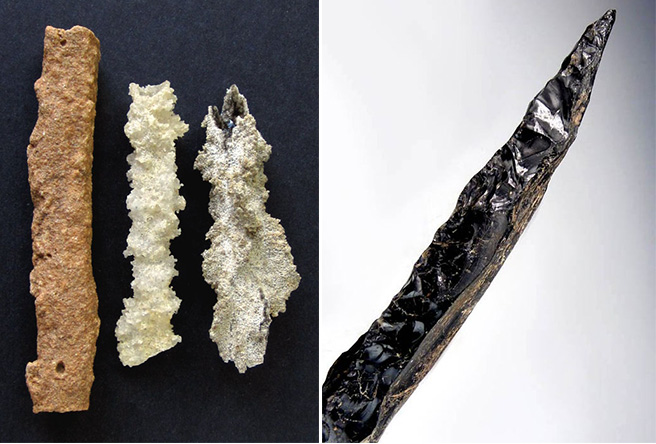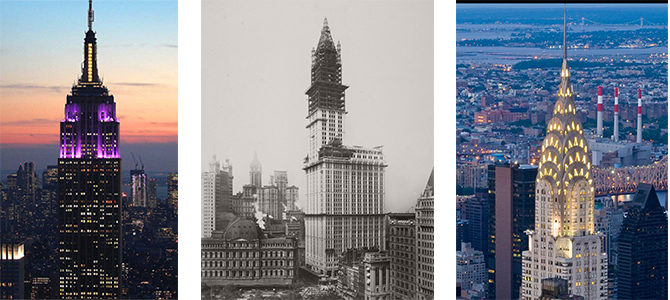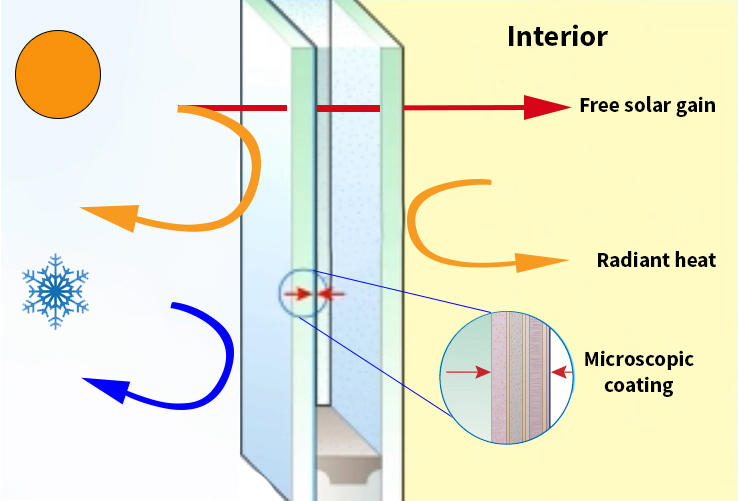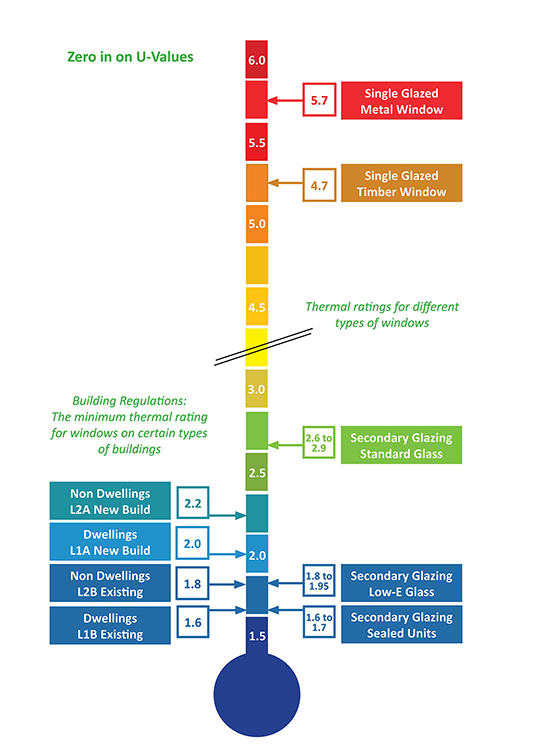Evidence of glass manufacture can be traced back to 40000 BC. Glass is made by raising the temperature of silica (sand), soda ash and limestone to their “melting point” of 600°C. At this heat the solid ingredients change into their liquid state. This process occurs in nature given the right mix of materials and intense heat in the guise of lightning strikes or volcanic eruptions. The resulting natural glass fulgurite and obsidian glass respectively were used by prehistoric man to fashion weapons and tools.
 Weapons made from fulgurite and obsidian glass
Glass has been used to glaze windows from the beginning of the first century AD. However, as it was an expensive precious material, it was only used in important buildings. The production of glass went through many and various manifestations until the development of the float process in the 1950s, which changed the face of architecture. This method proved so seminal that the process remains ostensibly the same to the current day.
With the development of mass manufactured float glass, architectural history was transformed. During the 1920s and 30s high rise buildings erupted into the New York and Chicago skylines. Over the ensuing years, these skyscrapers with their trademark expanse of glass, rose high above any potential cooling shade from neighbouring buildings or trees and therefore suffered from solar gain and heat loss. Inhabitants of these new buildings soon discovered that the interiors became unbearably hot during summer months and cold during winter months. The early 20th century solution to this problem was the development of double glazing together with the adoption of iron-rich (green tinted) glass. However, this proved an inadequate solution and for decades the problem of solar gain and heat loss was addressed by using space heating and cooling air conditioning systems.
Weapons made from fulgurite and obsidian glass
Glass has been used to glaze windows from the beginning of the first century AD. However, as it was an expensive precious material, it was only used in important buildings. The production of glass went through many and various manifestations until the development of the float process in the 1950s, which changed the face of architecture. This method proved so seminal that the process remains ostensibly the same to the current day.
With the development of mass manufactured float glass, architectural history was transformed. During the 1920s and 30s high rise buildings erupted into the New York and Chicago skylines. Over the ensuing years, these skyscrapers with their trademark expanse of glass, rose high above any potential cooling shade from neighbouring buildings or trees and therefore suffered from solar gain and heat loss. Inhabitants of these new buildings soon discovered that the interiors became unbearably hot during summer months and cold during winter months. The early 20th century solution to this problem was the development of double glazing together with the adoption of iron-rich (green tinted) glass. However, this proved an inadequate solution and for decades the problem of solar gain and heat loss was addressed by using space heating and cooling air conditioning systems.
 Early twentieth century high rise buildings
The energy crisis of the 1970s proved the catalyst for governments to investment in research and development to find a passive solution to solar gain. The knowledge gained and breakthroughs made during this period have formed the basis of the current low-E industry.
Low-E glazing has had and will continue to have a significant impact on the built environment. Low-E coating dramatically changes the inherent high emissivity of glass. Emissivity is a material’s ability to radiate long wave heat energy. This can be viewed as a negative property within the built environment, as windows are generally required to form part of the thermal envelope between the internal and external environment. A single pane of glass has a relatively high emissivity of 0.84. Its emissivity can be transformed with the addition of a low-E coating to 0.02.
There are two types of low-E glass which differ in the process of manufacture. One is produced by a ‘Pyrolytic Process’ where by the low-E coating is applied during the float process. This results in a hard coating which is very robust and more suited to colder climates. It allows a certain amount of short-wave energy from the sun’s light to pass through the glass, whilst preventing interior heat from escaping. This means buildings can still benefit from solar gain during cold winter months. The other method is the MSVD (Magnetron Sputter Vacuum Deposition) process which is applied post float process and produces a soft coat low-E glass. This is more vulnerable than a hard coating and needs to be protected from the atmosphere, so generally used in a sealed unit. Soft coat low-E glass is generally used in warmer climates, as it will reflect the sun’s rays away from your home and not allow them to enter through the windows.
Early twentieth century high rise buildings
The energy crisis of the 1970s proved the catalyst for governments to investment in research and development to find a passive solution to solar gain. The knowledge gained and breakthroughs made during this period have formed the basis of the current low-E industry.
Low-E glazing has had and will continue to have a significant impact on the built environment. Low-E coating dramatically changes the inherent high emissivity of glass. Emissivity is a material’s ability to radiate long wave heat energy. This can be viewed as a negative property within the built environment, as windows are generally required to form part of the thermal envelope between the internal and external environment. A single pane of glass has a relatively high emissivity of 0.84. Its emissivity can be transformed with the addition of a low-E coating to 0.02.
There are two types of low-E glass which differ in the process of manufacture. One is produced by a ‘Pyrolytic Process’ where by the low-E coating is applied during the float process. This results in a hard coating which is very robust and more suited to colder climates. It allows a certain amount of short-wave energy from the sun’s light to pass through the glass, whilst preventing interior heat from escaping. This means buildings can still benefit from solar gain during cold winter months. The other method is the MSVD (Magnetron Sputter Vacuum Deposition) process which is applied post float process and produces a soft coat low-E glass. This is more vulnerable than a hard coating and needs to be protected from the atmosphere, so generally used in a sealed unit. Soft coat low-E glass is generally used in warmer climates, as it will reflect the sun’s rays away from your home and not allow them to enter through the windows.
 Low-E microscopic coating – radiating heat back into the interior whilst facilitating solar gain
Demand for energy efficiency products continues to grow as building standards become increasingly more demanding, in response to governmental targets. Governments in their turn are required to achieve their agreed carbon budgets through on-going implementation of the Kyoto Protocol.
Heating and cooling air within the built environment accounts for half of the EU’s energy consumption a large proportion of which is supplied by fossil fuels, resulting in the built environment being responsible for 47% of all the UK’s carbon emissions. As with many statistics the devil is in the detail. The built environment is too broad a term as it is made up of two distinct entities; modern and traditional buildings; with traditional buildings making up 35% of all UK dwellings. The windows of traditional buildings typically consist of single glazed windows with wooden frames, these primary windows contribute disproportionately to the overall carbon emissions tally. Tackling this issue is complicated by the nature of the sector. Often traditional buildings are located within conservation areas which restrict or prohibit changes to fenestration. In some cases buildings have listed status which protects all historical features of which its windows are an important component. However, in the majority of cases, traditional buildings can be treated with secondary glazing.
Low-E microscopic coating – radiating heat back into the interior whilst facilitating solar gain
Demand for energy efficiency products continues to grow as building standards become increasingly more demanding, in response to governmental targets. Governments in their turn are required to achieve their agreed carbon budgets through on-going implementation of the Kyoto Protocol.
Heating and cooling air within the built environment accounts for half of the EU’s energy consumption a large proportion of which is supplied by fossil fuels, resulting in the built environment being responsible for 47% of all the UK’s carbon emissions. As with many statistics the devil is in the detail. The built environment is too broad a term as it is made up of two distinct entities; modern and traditional buildings; with traditional buildings making up 35% of all UK dwellings. The windows of traditional buildings typically consist of single glazed windows with wooden frames, these primary windows contribute disproportionately to the overall carbon emissions tally. Tackling this issue is complicated by the nature of the sector. Often traditional buildings are located within conservation areas which restrict or prohibit changes to fenestration. In some cases buildings have listed status which protects all historical features of which its windows are an important component. However, in the majority of cases, traditional buildings can be treated with secondary glazing.
 U-values achievable with the application of secondary glazing and low-E secondary glazing
Secondary glazing incorporating low-E glass can play an important part in reducing carbon usage in traditional and Listed buildings with single glazed windows which, untreated, can account for 20% of the overall heat loss from a building.
The lower the emissivity of the glazing, the lower the resulting U-value and using low-E secondary glazing a U-value of 1.6 is achievable. This not only reduces energy usage and the buildings carbon footprint but the embedded carbon in the original window is retained.
With internationally agreed carbon budgets to achieve, governments are galvanised as never before to achieving carbon reduction in the built environment. Secondary glazing can play an important part in achieving this goal.
U-values achievable with the application of secondary glazing and low-E secondary glazing
Secondary glazing incorporating low-E glass can play an important part in reducing carbon usage in traditional and Listed buildings with single glazed windows which, untreated, can account for 20% of the overall heat loss from a building.
The lower the emissivity of the glazing, the lower the resulting U-value and using low-E secondary glazing a U-value of 1.6 is achievable. This not only reduces energy usage and the buildings carbon footprint but the embedded carbon in the original window is retained.
With internationally agreed carbon budgets to achieve, governments are galvanised as never before to achieving carbon reduction in the built environment. Secondary glazing can play an important part in achieving this goal.
 Weapons made from fulgurite and obsidian glass
Glass has been used to glaze windows from the beginning of the first century AD. However, as it was an expensive precious material, it was only used in important buildings. The production of glass went through many and various manifestations until the development of the float process in the 1950s, which changed the face of architecture. This method proved so seminal that the process remains ostensibly the same to the current day.
With the development of mass manufactured float glass, architectural history was transformed. During the 1920s and 30s high rise buildings erupted into the New York and Chicago skylines. Over the ensuing years, these skyscrapers with their trademark expanse of glass, rose high above any potential cooling shade from neighbouring buildings or trees and therefore suffered from solar gain and heat loss. Inhabitants of these new buildings soon discovered that the interiors became unbearably hot during summer months and cold during winter months. The early 20th century solution to this problem was the development of double glazing together with the adoption of iron-rich (green tinted) glass. However, this proved an inadequate solution and for decades the problem of solar gain and heat loss was addressed by using space heating and cooling air conditioning systems.
Weapons made from fulgurite and obsidian glass
Glass has been used to glaze windows from the beginning of the first century AD. However, as it was an expensive precious material, it was only used in important buildings. The production of glass went through many and various manifestations until the development of the float process in the 1950s, which changed the face of architecture. This method proved so seminal that the process remains ostensibly the same to the current day.
With the development of mass manufactured float glass, architectural history was transformed. During the 1920s and 30s high rise buildings erupted into the New York and Chicago skylines. Over the ensuing years, these skyscrapers with their trademark expanse of glass, rose high above any potential cooling shade from neighbouring buildings or trees and therefore suffered from solar gain and heat loss. Inhabitants of these new buildings soon discovered that the interiors became unbearably hot during summer months and cold during winter months. The early 20th century solution to this problem was the development of double glazing together with the adoption of iron-rich (green tinted) glass. However, this proved an inadequate solution and for decades the problem of solar gain and heat loss was addressed by using space heating and cooling air conditioning systems.
 Early twentieth century high rise buildings
The energy crisis of the 1970s proved the catalyst for governments to investment in research and development to find a passive solution to solar gain. The knowledge gained and breakthroughs made during this period have formed the basis of the current low-E industry.
Low-E glazing has had and will continue to have a significant impact on the built environment. Low-E coating dramatically changes the inherent high emissivity of glass. Emissivity is a material’s ability to radiate long wave heat energy. This can be viewed as a negative property within the built environment, as windows are generally required to form part of the thermal envelope between the internal and external environment. A single pane of glass has a relatively high emissivity of 0.84. Its emissivity can be transformed with the addition of a low-E coating to 0.02.
There are two types of low-E glass which differ in the process of manufacture. One is produced by a ‘Pyrolytic Process’ where by the low-E coating is applied during the float process. This results in a hard coating which is very robust and more suited to colder climates. It allows a certain amount of short-wave energy from the sun’s light to pass through the glass, whilst preventing interior heat from escaping. This means buildings can still benefit from solar gain during cold winter months. The other method is the MSVD (Magnetron Sputter Vacuum Deposition) process which is applied post float process and produces a soft coat low-E glass. This is more vulnerable than a hard coating and needs to be protected from the atmosphere, so generally used in a sealed unit. Soft coat low-E glass is generally used in warmer climates, as it will reflect the sun’s rays away from your home and not allow them to enter through the windows.
Early twentieth century high rise buildings
The energy crisis of the 1970s proved the catalyst for governments to investment in research and development to find a passive solution to solar gain. The knowledge gained and breakthroughs made during this period have formed the basis of the current low-E industry.
Low-E glazing has had and will continue to have a significant impact on the built environment. Low-E coating dramatically changes the inherent high emissivity of glass. Emissivity is a material’s ability to radiate long wave heat energy. This can be viewed as a negative property within the built environment, as windows are generally required to form part of the thermal envelope between the internal and external environment. A single pane of glass has a relatively high emissivity of 0.84. Its emissivity can be transformed with the addition of a low-E coating to 0.02.
There are two types of low-E glass which differ in the process of manufacture. One is produced by a ‘Pyrolytic Process’ where by the low-E coating is applied during the float process. This results in a hard coating which is very robust and more suited to colder climates. It allows a certain amount of short-wave energy from the sun’s light to pass through the glass, whilst preventing interior heat from escaping. This means buildings can still benefit from solar gain during cold winter months. The other method is the MSVD (Magnetron Sputter Vacuum Deposition) process which is applied post float process and produces a soft coat low-E glass. This is more vulnerable than a hard coating and needs to be protected from the atmosphere, so generally used in a sealed unit. Soft coat low-E glass is generally used in warmer climates, as it will reflect the sun’s rays away from your home and not allow them to enter through the windows.
 Low-E microscopic coating – radiating heat back into the interior whilst facilitating solar gain
Demand for energy efficiency products continues to grow as building standards become increasingly more demanding, in response to governmental targets. Governments in their turn are required to achieve their agreed carbon budgets through on-going implementation of the Kyoto Protocol.
Heating and cooling air within the built environment accounts for half of the EU’s energy consumption a large proportion of which is supplied by fossil fuels, resulting in the built environment being responsible for 47% of all the UK’s carbon emissions. As with many statistics the devil is in the detail. The built environment is too broad a term as it is made up of two distinct entities; modern and traditional buildings; with traditional buildings making up 35% of all UK dwellings. The windows of traditional buildings typically consist of single glazed windows with wooden frames, these primary windows contribute disproportionately to the overall carbon emissions tally. Tackling this issue is complicated by the nature of the sector. Often traditional buildings are located within conservation areas which restrict or prohibit changes to fenestration. In some cases buildings have listed status which protects all historical features of which its windows are an important component. However, in the majority of cases, traditional buildings can be treated with secondary glazing.
Low-E microscopic coating – radiating heat back into the interior whilst facilitating solar gain
Demand for energy efficiency products continues to grow as building standards become increasingly more demanding, in response to governmental targets. Governments in their turn are required to achieve their agreed carbon budgets through on-going implementation of the Kyoto Protocol.
Heating and cooling air within the built environment accounts for half of the EU’s energy consumption a large proportion of which is supplied by fossil fuels, resulting in the built environment being responsible for 47% of all the UK’s carbon emissions. As with many statistics the devil is in the detail. The built environment is too broad a term as it is made up of two distinct entities; modern and traditional buildings; with traditional buildings making up 35% of all UK dwellings. The windows of traditional buildings typically consist of single glazed windows with wooden frames, these primary windows contribute disproportionately to the overall carbon emissions tally. Tackling this issue is complicated by the nature of the sector. Often traditional buildings are located within conservation areas which restrict or prohibit changes to fenestration. In some cases buildings have listed status which protects all historical features of which its windows are an important component. However, in the majority of cases, traditional buildings can be treated with secondary glazing.
 U-values achievable with the application of secondary glazing and low-E secondary glazing
Secondary glazing incorporating low-E glass can play an important part in reducing carbon usage in traditional and Listed buildings with single glazed windows which, untreated, can account for 20% of the overall heat loss from a building.
The lower the emissivity of the glazing, the lower the resulting U-value and using low-E secondary glazing a U-value of 1.6 is achievable. This not only reduces energy usage and the buildings carbon footprint but the embedded carbon in the original window is retained.
With internationally agreed carbon budgets to achieve, governments are galvanised as never before to achieving carbon reduction in the built environment. Secondary glazing can play an important part in achieving this goal.
U-values achievable with the application of secondary glazing and low-E secondary glazing
Secondary glazing incorporating low-E glass can play an important part in reducing carbon usage in traditional and Listed buildings with single glazed windows which, untreated, can account for 20% of the overall heat loss from a building.
The lower the emissivity of the glazing, the lower the resulting U-value and using low-E secondary glazing a U-value of 1.6 is achievable. This not only reduces energy usage and the buildings carbon footprint but the embedded carbon in the original window is retained.
With internationally agreed carbon budgets to achieve, governments are galvanised as never before to achieving carbon reduction in the built environment. Secondary glazing can play an important part in achieving this goal.- Date
- Category
- Secondary Glazing in Practice